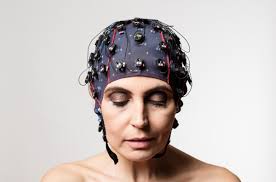
Imagine a world where your devices know what you’re thinking before you even say a word. This may sound like science fiction, but advances in wearable brain-reading technology are bringing that reality closer than ever. Scientists and engineers are developing headsets, caps, and even earbuds that can interpret brain activity to control devices, improve mental health, and enhance human-computer interaction.
1. How Mind-Reading Wearables Work
These devices rely on electroencephalography (EEG) or similar sensors to detect electrical signals in the brain. When neurons fire, they produce tiny electrical patterns that can be measured and analyzed. Wearables then use AI algorithms to interpret these signals, translating thoughts, intentions, or emotional states into actionable data.
Some applications include:
- Controlling devices: Move a cursor, type, or operate smart home devices using thoughts.
- Monitoring mental health: Detect stress, anxiety, or focus levels in real time.
- Enhancing learning: Track attention and adapt educational content dynamically.
2. Current Applications in the Real World
While full telepathy is still a dream, current wearable tech has impressive uses:
- Gaming: Players can control games using brain activity instead of traditional controllers.
- Rehabilitation: Stroke patients use mind-controlled robotic limbs for recovery.
- Productivity tools: Devices track focus patterns and suggest optimal work-rest cycles.
- Meditation and mental health: Wearables measure stress and guide relaxation exercises.
These innovations are just the beginning of thought-driven interfaces.
3. The Technology Behind It
Wearable mind-reading tech combines several scientific fields:
- Neuroscience: Understanding how brain signals correlate with thoughts and emotions.
- Signal processing: Filtering out noise to detect meaningful brain patterns.
- Artificial intelligence: Machine learning algorithms translate raw signals into commands or insights.
- Miniaturization: Making sensors small, lightweight, and wearable without sacrificing accuracy.
4. Challenges and Limitations
Despite progress, the technology faces hurdles:
- Accuracy: Brain signals are weak and noisy, making interpretation difficult.
- Privacy concerns: Mind-reading devices could expose thoughts without consent.
- Limited understanding: The human brain is still largely a mystery, so full thought decoding remains out of reach.
- Accessibility: High costs and technical complexity currently limit widespread adoption.
5. The Future of Mind-Reading Wearables
Scientists predict a future where:
- Hands-free control of computers, phones, and even vehicles becomes common.
- Mental health monitoring is continuous, enabling early detection and intervention.
- Enhanced communication could allow people with disabilities to interact fully with the world using only thoughts.
- Brain-to-brain communication may eventually be possible, enabling direct transfer of ideas.
The possibilities are vast, but ethical considerations will be just as important as the technology itself.
Final Thoughts
Wearable mind-reading tech represents a profound leap in human-computer interaction. By bridging the gap between thought and action, it promises to enhance lives, empower people with disabilities, and redefine how we connect with technology. While the future is still unfolding, one thing is clear: the era of mind-controlled devices is arriving faster than most of us expected.